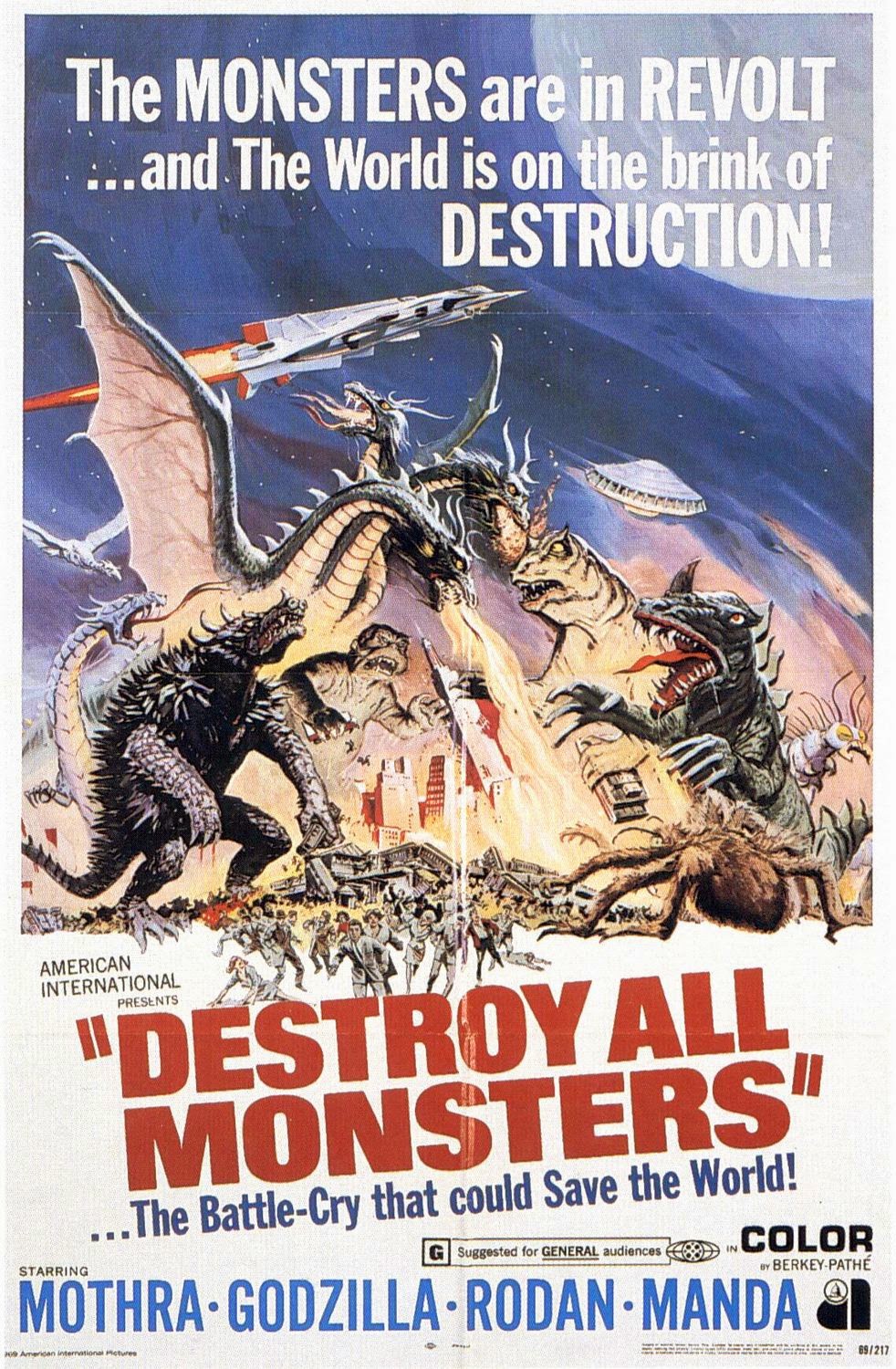DAY TEN
DESTROY ALL
MONSTERS (1968)
aka. Charge of the Monsters
It's The Avengers of Japanese monster movies! It's the House of Frankenstein of rubber suit monster mayhem. Filling the frame with kaiju, it's Destroy All Monsters! Considered by many as a classic installment in the Godzilla series, Destroy All Monsters is a celebration of Toho's tokusatsu history and also a farewell to the golden age of Japanese monster movies.
By 1968, the Japanese film industry was on the decline. With the rise of more science fiction and fantasy TV shows with smaller budgets and wider audiences, Japanese genre movies were starting to loose their steam. Sensing perhaps that the time for Godzilla-style monster movies was passing, Toho planned one last hurrah with their stable of monster characters.
Destroy All Monsters would reunite the original
Gojira creative team of director Ishiro Honda, composer Akira Ifukube, and producer Tomoyuki Tanaka for the last time. Taking Godzilla back to its sci-fi roots after two years of subpar kid's fare, Ishiro Honda decided to make this potentially final Godzilla film one that little monster-loving kids would never forget. Under modern analysis,
Destroy All Monsters certainly doesn't win any awards for originality. It essentially recycles the plot of the much superior
Invasion of Astro-Monster (1965) but with a lot less charm. Nevertheless, it features aliens, rocket ships, moon bases, subterraneon facilities, widespread metropolitan destruction, and a crossover between some of the biggest monsters Toho had to offer for an epic final battle that's well worth the price of admission.
 |
| Ain't no party like a kaiju party! |
In the futuristic year of 1999, space travel to and from the moon is as routine as intercontinental jet flight. The world lives in apparent harmony under the guidance of the UN. But what of the world's monsters? They're no threat either. They've all been peacefully relocated to the Ogasawara Islands at a research facility known as Monsterland. Contained by technology, the world's monsters co-exist without strife or want. That is until a race of female aliens from the planet Kilaak come to Earth and take control of the facility, releasing the monsters and then unleashing them on the world's major cities, controlling each monster via radio waves in an attempt to extort the Earth into surrendering.
The world now faces destruction at the hands of.....
 |
| GOROSAURUS (from King Kong Escapes) |
 |
| MOTHRA |
 |
| BARAGON (Frankenstein Conquers the World) |
 |
| VARAN (Varan: The Unbelievable) |
 |
| MANDA (Atragon) |
 |
| KUMONGA (Son of Godzilla) |
 |
| ANGUIRUS (Godzilla Raids Again) |
 |
| RODAN |
 |
| GODZILLA and MINILLA (Son of Godzilla) |
Hell yeah! Look at all those kaiju. New York, Paris, Peking, Moscow: all fall before the world's mightiest monsters. It makes you forget for a minute this movie makes no sense. Why do the Kilaakians want to take over Earth even though it's revealed that they require intense heat just to stay alive? Who knows, but look at Godzilla attack the UN building! Have you noticed the lack of characterization and chemistry between stars
Akira Kubo and Yukiko Kobayashi? Nope! Too busy watching Anguirus, Godzilla, Mothra, and Rodan crushing tanks into bits. In the context of 1968, given the kind of budget-cutting Toho was undergoing, Destroy All Monsters completely succeeds on its special effects sequences alone, even if the story's incredibly hollow and slim.
Although there's only one scene of urban destruction, and we won't see another one for several more years, it's a real treat. The real show-stopper, however, comes in the film's final battle. With the Kilaakian control over the Earth's monsters disabled, the Kilaakians call in backup from outerspace.....KING GHIDORAH! The terrible three-headed flying dragon last seen in
Invasion of Astro-Monster returns to take on a staggering nine monsters at once. Godzilla, who has completed his metamorphosis into world hero, leads the charge against Ghidorah in an epic knock down, drag out battle of tooth and claw with nothing less than the entire Earth at stake. It's one of the finest examples of suitmation monster fighting in Godzilla history and, honestly, the set piece on which the entire film is built. So damn good.
Even with its kid-friendly elements,
Destroy All Monsters never panders as much to children as
Son of Godzilla did before it, but the tide is about to change for good.
Destroy All Monsters is an island of quality science fiction and fantasy special effects s in a sea of budget cuts and a shifting demographics that will soon reduce the output of Toho monster movies to rudimentary kid's stuff. Following
Destroy All Monsters, Toho will continue to produce Godzilla movies in the Showa era without interruption until 1975, but none of them will ever marry so perfectly Ishiro Honda's optimism for the future with Eiji Tsuburaya and Sadamasa Arikawa's special effects prowess. If
Destroy All Monsters is the big goodbye to the better days of Godzilla movies in the Showa period, so be it. I can overlook the flaws in the story and let the monsters bask for one last time in the limelight.
PHOTOS
With the better days of the Japanese film industry behind them, Toho would devote the bulk of its Godzilla output towards capturing the hearts and minds of the children who were making TV monster shows and kid-centric monster movies like the Gamera series such a success. Tomorrow, in our the next chapter of 30 Days of Godzilla, we look at the most kid-oriented Godzilla movie of them all: ALL MONSTERS ATTACK!


















.jpg)






No comments:
Post a Comment